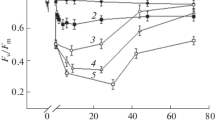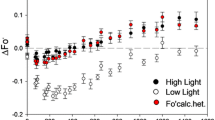Abstract
When totally etiolated pea epicotyls were cut into segments and incubated with potassium phosphate buffer, pH 6.0, in the dark at 25 C, an instantaneous loss of photoreversible absorbance change, Δ (ΔA) between 660 and 730 nm, was observed after the first irradiation with actinic red light in the spectrophotometric measurement of phytochromein vivo. The shorter the epicotyl segments, and the longer the period of dark incubation, the greater was the loss detected in the measurement.
A remarkable decline of Δ(ΔA) in the far-red region was seen inin vivo difference spectra for phytochrome, after the epicotyl segments were incubated in the dark at 25 C. As the period of dark incubation was prolonged, the ratio of the maximal change of Δ(ΔA) in the far-red region to that in the red region was reduced. It decreased to ca. one third of the initial value after incubation for 8 hr.
The evidence indicates that Pfr killer activity and P* denaturation, both of which have so far been known onlyin vitro, can also occur in segments of etiolated pea epicotyls.
Similar content being viewed by others
Abbreviations
- Pr:
-
red light absorbing form of phytochrome
- Pfr:
-
far-red light absorbing form of phytochrome
- P* :
-
denaturation, protein denaturation of phytochrome resulting in decrease of Δ Afr/Δ Ar
- F1 :
-
the first actinic far-red light
- F2 :
-
the second actinic far-red light
- R1 :
-
the first actinic red light
- S1 :
-
a 4 mm-long stem region cut from 1 mm below the apcial hook of an etiolated pea epicotyl, equivalent to the S1 of Purves and Hillman (1958) except that the latter was 5 mm long
- pCMB:
-
p-mercuribezonate
- mg fr wt:
-
mg fresh weight
References
Butler, W.L., H.W. Siegelman andC.O. Miller. 1964. Denaturation of phytochrome. Biochemistry3: 851–857.
Chorney, N. andS.A. Gordon. 1966. Action spectrum and characteristics of the light activated disappearance of phytochrome in oat seedlings. Plant Physiol.41: 891–896.
Clarkson, D.T. andW.S. Hillman. 1967. Modification of apparent phytochrome synthesis inPisum by inhibitors and growth regulators. Plant Physiol.42: 933–940.
Fox, L.R. 1975. Loss of phytochrome photoreversibilityin vitro. I. Extraction and partial purification of killer. Plant Physiol.55: 386–389.
— 1977. The loss of phytochrome photoreversibilityin vitro. II. Properties of killer and its reaction with phytochrome. Planta135: 217–223.
Frankland, B. 1972. Biosynthesis and dark transformations of phytochrome.In: K. Mitrakos and W. Shropshire, Jr., ed., Phytochrome p. 195–225. Academic Press, London.
Furuya, M. 1968. Biochemistry and physiology of phytochrome. Prog. Phytochem.1: 347–405.
— andW.S. Hillman. 1964. Observations on spectrophotometrically assayable phytochromein vivo in etiolatedPisum seedlings. Planta63: 31–42.
—. 1966. Rapid destruction of the Pfr form of phytochrome by a substance in extracts ofPisum tissue. Plant Physiol.41: 1242–1244.
Hillman, W.S. 1965. Phytochrome conversion by brief illumination and the subsequent elongation of etiolatedPisum stem segments. Physiol. Plant.18: 346–358.
— 1968. The physiology of phytochrome Ann. Rev. Plant Physiol.18: 301–324.
Hopkins, W.G. andW.S. Hillman. 1965. Phytochrome changes in tissues of dark-grown seedlings representing various photoperiodic classes. Amer. J. Bot.52: 427–432.
Pratt, L.H. andS.C. Cundiff. 1975. Spectral characterization of high-molecular-weight phytochrome. Photochem. Photobiol.21: 91–97.
Purves, W.K. andW.S. Hillman. 1958. Response of pea stem sections to indoleacetic acid, gibberellic acid and sucrose as affected by light and distance from apex. Physiol. Plant.11: 29–35.
Yamamoto, K.T. andM. Furuya. 1975. Photoreversible bindingin vitro of cytosolic phytochrome to particulate fraction isolated from pea epicotyls. Planta127: 177–186.
Author information
Authors and Affiliations
Rights and permissions
About this article
Cite this article
Shimazaki, Y., Furuya, M. Apparent Pfr killer reaction and P* denaturation in segments of etiolated pea epicotyl. Bot Mag Tokyo 91, 255–261 (1978). https://doi.org/10.1007/BF02488939
Received:
Issue Date:
DOI: https://doi.org/10.1007/BF02488939




